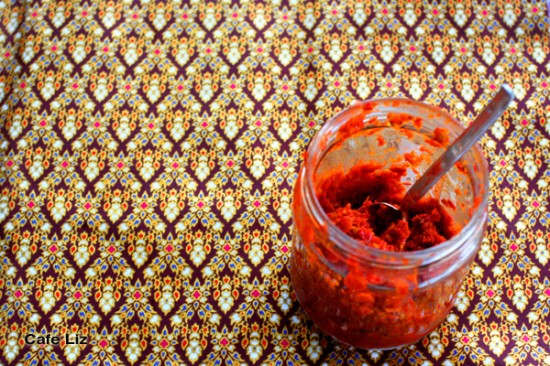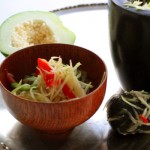
In the back of my fridge is a slowly shrinking bag of green mush that I’ve been guarding jealously. It’s the remainders of the half-kilo of handmade green curry paste that we purchased from our favorite restaurant in Chiang Mai, longer ago than I should probably admit (OK, it was a year and a half ago). How could I use it generously when I knew that once it was gone, the only replacement I’d find was something imported in little plastic tubs whose quality and flavor were complete unknowns?
Now, the biggest barrier to making fresh Thai curry in Israel has been lifted — fresh galangal is here, and I’ve bought a nice, fat root that should last me a while.
Mind you, there are still other challenges, as there are whenever you try to prepare a foreign cuisine. Beyond the question of whether foreign flavors meet local tastes, there’s the whole matter of ingredients — looking at this list of Thai vegetables, you’ll probably notice a whole lot that you’ll never find here (well, not yet, at least).
But negatives aside, we now have access to nearly all the main aromatics, the things that set the taste. So I whipped up my very own batch of curry paste, and while they might do it a bit differently in Thailand, it happened to taste quite good. And that’s the most important thing.
Thai curry paste is traditionally made in a stone mortar and pestle, which easily grinds tough herbs into a smooth paste. I don’t have one up to the job — just a dinky little thing that crushes spices — so I crushed some of the ingredients in a garlic press, and ground up the rest in a blender.
Also, Thai curry paste traditionally includes oyster paste and fish sauce. You can find those ingredients here, at East West for instance, but obviously I left them out so that my curry would be kosher and vegetarian.
Beyond that, this recipe is based more or less on one I learned at a cooking school in Chaing Mai. It’s not spicy at all, if you ask me, and next time I’ll probably change the ratio of sweet peppers versus hot peppers. Remember, though, you can always add more hot pepper to your curry itself. Or, on the other hand, if you can’t handle any hotness at all, use only sweet peppers and no hot peppers.
For about 200 ccs (225 grams) of red curry:
20 grams dried sweet peppers (the big dried red peppers)
5 grams dried hot peppers (the smaller dried peppers)
15 grams chopped lemon grass (the fat bottom half of the stalks, not the leaves — this equals 1 to 2 stems)
20 grams fresh galangal (a fat disc or two)
2 grams fresh turmeric (a small piece)
50 grams garlic (about 10 cloves)
100 g shallots (4-5 fat shallots)
10 gram lime zest (1 lime — traditionally this is kaffir lime, but the only kaffir lime here is dried)
1 teaspoon salt
1 teaspoon coriander seeds, toasted
1/4 teaspoon cumin, toasted
Toast the coriander and cumin in a dry frying pan until it begins to pop. Crush in a mortar and pestle, and set aside.
Set the dried peppers in water to soak.
Now, put on glasses — the shallots will make you cry otherwise. Also, once you start handling the hot peppers, don’t touch your face — that’ll also make you cry.
If you have a big stone mortar and pestle, then use it to reduce the rest of the ingredients into a paste, starting with the toughest ones, such as galangal and lemon grass (chop the lemon grass first).
If not, you can use a mix of a garlic press and a blender. Cut the shallots into chunks, and crush them, the garlic and the turmeric in a garlic press. This takes a lot of muscle.
Remove the peppers from the water, and dry them off. Mix the crushed garlic, etc. with the other ingredients and blend, either with a stick blender or in an actual blender, until smooth.

To make your curry paste into an actual curry:
For about four servings:
Fry a few heaping spoonfuls in some oil, until it gets fragrant. Then add a can of coconut milk, a handful of chopped tofu cubes, vegetables such as a few mini-eggplants (chopped), diced carrots, ripped oyster mushrooms, and a hot pepper or two, chopped into large pieces. Boil for a few minutes until the vegetables are soft, adding some water as the mixture boils down.
Turn off the flame, and mix in a handful of ripped basil leaves. Add sugar and salt (or fish sauce) to taste.





